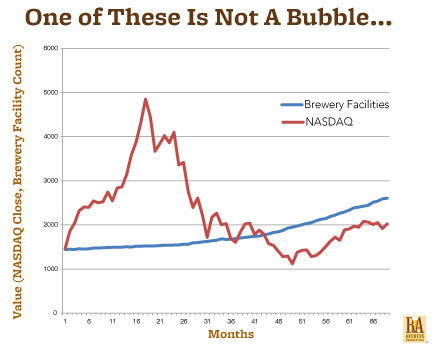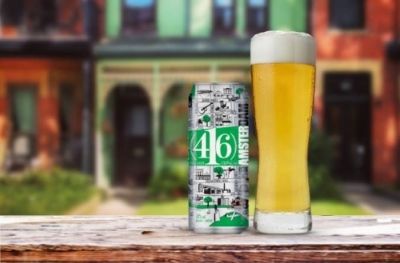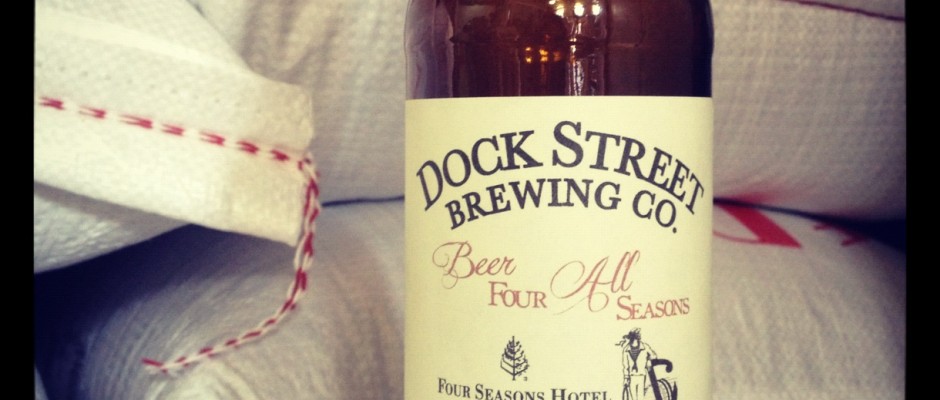Mmmmm, beer. That was the philosophy of Homer Simpson, and many Americans would agree. One of the great food and drink stories in recent years has been the rapid rise of craft beer. Today, independents represent about eight percent of total U.S. beer sales, and the number of breweries just topped 3,000, a level not seen since the 1870s.
With thousands more in the works, that number is likely to keep going up. So have we reached our saturation point? The Brewers Association, a nonprofit trade group, certainly doesn’t think so — their staff beer economist (best title ever) calls it a “craft beer non bubble.” The organization points out there are 7,000 wineries in the U.S., yet very little talk of a wine bubble.
 The Brewers Assoc. charts NASDAQ against beerCraft beer is in many ways a reflection and driver of the local food movement. In an age of massive corporate brands, people are thirsty for experiences like riding your bike to the local brewpub and quaffing a draft produced on-site. The beer boom has not only created jobs, but also played a key role in the rise of local restaurant scenes and neighborhood revitalization.
The Brewers Assoc. charts NASDAQ against beerCraft beer is in many ways a reflection and driver of the local food movement. In an age of massive corporate brands, people are thirsty for experiences like riding your bike to the local brewpub and quaffing a draft produced on-site. The beer boom has not only created jobs, but also played a key role in the rise of local restaurant scenes and neighborhood revitalization.
Yet how local is your beer? Most wines are grown on local estates, yet the ingredients in beer often come from a catalogue. It can be difficult to find locally-grown hops, barley and other ingredients in the U.S. and Canada. North American hop production is concentrated in the Pacific Northwest, while a lot of barley comes from the Dakotas.
That's starting to change as brewers seek out more local ingredients — organic honey, fresh fruit or local “wet” (green) hops. There are also an increasing number of breweries trying to source items such as local barley, and that’s helping to fuel the production of these plants.
Brewing innovation in Philly
Dock Street Brewing Co., a brewpub on bustling Baltimore Avenue in West Philadelphia, has always prided itself on sourcing locally — the beef for their burgers comes from Lancaster County, and during the warm-weather months the menu bursts with inventive salad specials and veggie-heavy pizzas. That ideology also extends to their ever-evolving roster of beers.
According to Dock Street's Marilyn Candeloro, they purchase almost all of their brewing ingredients domestically (certain recipes do demand the milder English hops). And, when they can, they narrow their food shed even further, incorporating products from Pennsylvania, Philadelphia, and even West Philly itself.
Every fall, Dock Street brews their wildly popular Satellite Espresso Stout using locally roasted organic fair trade beans from Standing Stone Coffee Company in Huntingdon, PA. They've also teamed up with the Four Seasons Hotel Philadelphia on the limited-run “A Beer Four All Seasons” series.
“For those beers, some ingredients were sourced from the Four Seasons,” says Candeloro. “It could have been from their rooftop garden or a local purveyor that they work with. For the 'Spanish Fly,' they grew the verbena, the ginger and the wormwood for us.”
 Dock Street Brewing Company’s Whiter Shade of PaleAnd if that's not local enough for you, last year Dock Street tapped a batch of “Born and Raised.”
Dock Street Brewing Company’s Whiter Shade of PaleAnd if that's not local enough for you, last year Dock Street tapped a batch of “Born and Raised.”
“Around fall, all the brewers do a fresh-hopped beer, because that's when the harvest is,” explains Candeloro. “It turns out our neighbor Frank Winslow — who works at Yards Brewing as their quality assurance brewer — grows his own hops at home, and last year he couldn't use them because he didn't have enough to make a dent in a Yards recipe. So, he gave us the hops. Most often, you're overnighting them from Washington or Oregon, so it was really awesome that we got them right around the corner.”
Of course all this experimentation is enabled by an increasingly beer-obsessed customer base boasting adventurous palettes.
“We have a great audience for the beers we put out,” insists Candeloro. “They're very receptive, and give us great feedback…People like to connect dots. With the espresso, they like that it's made right in PA. It makes them proud to drink it.”
In a couple weeks, Candeloro herself will drive out to New Jersey to pick up a truckload of white and yellow peaches. They'll be roasted in the Dock Street ovens, and thrown into a batch of “Whiter Shade of Pale,” a berliner weisse due in late August.
Beer explosion in the Twin Cities
In 2013, 14 new craft breweries opened in the Twin Cities. So did Minneapolis’ first micro-distillery, Norseman Distillery. Many of the startups take pride in incorporating local ingredients into their creations. While crafting its first batch of Strawberry Rhubarb Gin this spring, Scott Ervin, Norseman’s founder and head distiller, put out a call on Facebook for more local rhubarb.
Summit Brewing Company, which has been open since 1986 and is often credited with introducing microbrewing to the Twin Cities, has long been offering seasonal and specialty brews featuring homegrown ingredients. Last summer, Summit’s State Fair IPA, available only in its booth at the Minnesota State Fair, incorporated corn and wild rice from Minnestalgia Foods, raw wildflower honey from Bare Honey and Cascade hops from Hippity Hops Farms.
 Mark Stutrud of Summit Brewing CompanyBack in 2010, Summit brewed an Imperial Pumpkin Porter with organic pumpkins grown on the Wisconsin farm of a packaging line employee. This year’s brew in Summit’s ongoing Unchained Series, Herkulean Woods, is being made with maple syrup from Wild Country in Lutsen, Minn., and spruce tips from Iowa.
Mark Stutrud of Summit Brewing CompanyBack in 2010, Summit brewed an Imperial Pumpkin Porter with organic pumpkins grown on the Wisconsin farm of a packaging line employee. This year’s brew in Summit’s ongoing Unchained Series, Herkulean Woods, is being made with maple syrup from Wild Country in Lutsen, Minn., and spruce tips from Iowa.
Summit has also “worked with Rahr Malting in Shakopee as our primary maltster since the early days of our brewery,” explains Carey Matthews, Summit’s marketing coordinator. “They are using malt from North America and doing the malting on site at their Minnesota facility.”
“We try to partner with Minnesota companies as much as possible,” adds Matthews. “We value working with our neighbors and contributing even more to the local economy.”
Matthews regrets, however, that there aren’t barley or hops farms in Minnesota that can support large scale commercial brewing needs like Summit’s. Still, for home brewers who want to volunteer, the Longfellow Community Garden in Minneapolis has a plot solely devoted to growing hops. Later this summer, the gardener-brewers will reap their reward.
The brainchild of Andrew Schmitt, executive director of the Minnesota Beer Activists, the community hops garden was planted last year with donated cuttings now growing on 16-foot arbors (donated by Hippity Hops) and an aluminum-cabling-and-twine trellis to hold them aloft. To water the hops, volunteers created a rainwater catchment system that collects precipitation off nearby buildings.
“Beer is fundamentally a community beverage,” says Schmitt. “With this hops garden, we’re extending the community aspect of beer right down to how the hops are grown.”
“Everyone is excited about brewing beer with hops this fall that are fresh, right off the plant,” he adds. “I would love to see our community hops garden start a movement in other cities.”
Canada's craft beer culture
Toronto, Ontario is a city where it’s not hard to find a unique craft brew. Over the past few years, brewers have been popping up from the west to the east, with most neighborhoods now having a brewery to call its own.
 (416) Local Lager, Amsterdam Brewing CompanyCraft brewers are turning to local ingredients. Amsterdam is Toronto’s largest craft brewer. The company has always used Canadian raspberries in its popular summer Frambroise (they incorporate 2.2 pounds of fresh raspberries per 750 ml bottle). Then, about five years ago, Amsterdam started making local ingredients and local partnerships a priority. Recently, they have concentrated their efforts on their unique barrel program, turning to the Niagara wine region for inspiration. Not only does Amsterdam age special brews in wine barrels, but they use wild yeast grown in the region as a central ingredient.
(416) Local Lager, Amsterdam Brewing CompanyCraft brewers are turning to local ingredients. Amsterdam is Toronto’s largest craft brewer. The company has always used Canadian raspberries in its popular summer Frambroise (they incorporate 2.2 pounds of fresh raspberries per 750 ml bottle). Then, about five years ago, Amsterdam started making local ingredients and local partnerships a priority. Recently, they have concentrated their efforts on their unique barrel program, turning to the Niagara wine region for inspiration. Not only does Amsterdam age special brews in wine barrels, but they use wild yeast grown in the region as a central ingredient.
“Using local wine barrels where we can walk the vineyard and talk to the winemaker is something that we really focus in on,” explains McOustra.
By working with wineries less than an hour away from the city, Amsterdam has been able to be directly involved in the process — their customers get to know exactly where the beer and its ingredients are coming from. The brewery works with three vineyards in particular: Southbrook Vineyards, The Organized Crime Winery, and The Good Earth Food & Wine Co.
Utilizing these local suppliers helps with quality control, and adds an important element to each beer’s story. For example, Amsterdam will age wort in the middle of a Niagara vineyard for 16 hours before harvesting it, in order to capture the taste of the environment. Of course, it also means that many beers can only be brewed for a short period of time. Amsterdam has a wet hop seasonal that can only be brewed for a one to two week period in late summer. This particular brew is made by taking hops grown in Collingwood directly from the vine and adding them into a kettle, which they bring and utilize on-site.
“You don’t get much more local than that in brewing,” McOustra says.
More than a slogan in Cleveland
Walk through any of Cleveland’s percolating neighborhoods and you’re bound to spot new breweries and the people who love them. Like many cities, Cleveland is experiencing a bona fide beer boom, with a dozen or so new startups launched or about to launch in the last year alone. Around here, “Drink Local” is more than a pithy slogan — it’s a delicious directive that encourages craft beer fans to sidestep the macros in favor of their neighbors, and in return, those brewers are going out of their way to do the same.
“We like to support small, local, independent producers as much as we can,” says Matt Cole, brewer of one of the winningest IPAs in the nation, Fat Head's Brewery's Head Hunter.
Cole points to local agricultural products such as honey and maple syrup — both produced in abundance in Northeast Ohio. The brewery’s Incubus Maple Belgian Tripel is made with maple syrup sourced from nearby Ashland, giving the beer a crisp, sweet finish.
The same holds true for honey, which Cole “steals from some very angry bees” at a nearby apiary to brew his popular Bumble Berry Honey Blueberry Ale.
“It’s not the cheapest product around, but it’s a great product,” he explains. “And it’s a good way to connect with local businesses.”
Fat Head’s also might be one of the only breweries in the state to crowdsource a crucial ingredient. In spring 2013, the brewery handed out 75 baby hop plants to customers on a first-come, first-served basis. They were given care and feeding instructions and told when and how to harvest the hops. Those fresh hops were collected at the brewery and used to craft Hopportunity Knocks IPA. Of course, those grassroots growers were the first to sample the suds when ready.
“The whole exercise was about getting people excited about growing hops at home,” says Cole.
 Brian Benchek of The Bottlehouse Brewery. Photo by Bob Perkoski. Giving the phrase “fair trade coffee” new meaning, The BottleHouse, a small-batch brewery and meadery in Cleveland Heights, paired up with Rising Star Coffee Roasters to produce its Rising Star Stout. The brewers add the ground beans directly to the secondary fermentation. And BottleHouse doesn’t pay a cent for the pricy ingredient.
Brian Benchek of The Bottlehouse Brewery. Photo by Bob Perkoski. Giving the phrase “fair trade coffee” new meaning, The BottleHouse, a small-batch brewery and meadery in Cleveland Heights, paired up with Rising Star Coffee Roasters to produce its Rising Star Stout. The brewers add the ground beans directly to the secondary fermentation. And BottleHouse doesn’t pay a cent for the pricy ingredient.
“We don’t pay anything for the coffee,” explains brewer Brian Benchek. “Instead, we put their name right on the bottle.”
This unique relationship introduces the Rising Star brand to Bottlehouse fans, and the Bottlehouse brand to Rising Star supporters.
“We try to look for those types of arrangements as often as we can,” adds Benchek.
